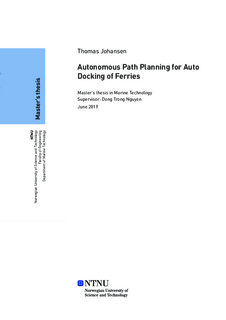| dc.contributor.advisor | Nguyen, Dong Trong | |
| dc.contributor.author | Johansen, Thomas | |
| dc.date.accessioned | 2019-10-17T14:01:36Z | |
| dc.date.available | 2019-10-17T14:01:36Z | |
| dc.date.issued | 2019 | |
| dc.identifier.uri | http://hdl.handle.net/11250/2622905 | |
| dc.description.abstract | Hovedproblemet i denne oppgaven har vært å identifisere og utvikle en algoritme for baneplanlegging for auto dokking av autonome ferjer. Den foreslåtte planleggeren løser problemet som er ulineært optimeringsproblem og bruker CasADi i Matlab for å løse dette. Planleggeren modellerer fartøyet med en 3DOF kinematisk modell med fem eller seks tilstander og to eller tre kontrollinput, avhengig av operasjonen. Planleggeren løser optimeringsproblemet og gir ut en tidsreferanse for banen som kontrollsystemet skal følge. For å teste planleggeren brukes det tre forskjellige scenario med ulike hindringer, start, og slutttilstander. Planleggeren klarer å løse problemet og finne den optimale løsningen innenfor de gitte grensene, men resultatet avhenger veldig av oppsettet på optimeringsproblemet. Banereferansene testes i både simuleringer og modellforsøk for å sjekke at de faktisk er mulig å følge. Resultatene viser at det går bra, men de må justeres for å passe kontroll-sytemene. Oppgaven inneholder også et litteratur studie om autonome overflatefartøy, sensor integrering og modellering, baneplanlegging, modellprediktiv regulering, og ulineær optimering. Resultatene fra dette er bakgrunnen for valget av ulineær optimering for å løse baneplanleggings problemmet og hvilken informasjon som skal inkluderes i planleggeren.
Hovedresultatet fra oppgaven er at ulineær optimering er en god metode for baneplanlegging for autonome ferjer, både for dokking og overfart. Men, det er fortsatt nødvendig å utvikle planleggeren videre for å gjøre den mer effektiv og inkludere mer informasjon om både fartøyet og forstyrrelser som kan påvirke fartøyets bevegelser. | |
| dc.description.abstract | The main task in this thesis has been to identify and develop an algorithm for path planning in auto docking of autonomous ferries. The proposed planner treats the planning problem as a nonlinear optimization problem, and uses CasADi in Matlab to solve this optimization problem. The planner models the vessel using a 3DOF kinematic model, with five or six states and two or three inputs, depending on the operation. The planner solves the optimization and produces a reference trajectory for the control system to follow. To test the planner, three different scenarios with varying obstacles, initial, and final conditions are specified. The planner manages to solve the problem and find the optimal solution within the given constraints, but it depends strongly on how the optimization is set up. The trajectories are tested in both simulators and experimental tests, to verify that they can actually be followed. The results here show that the trajectories are possible to follow, but they must be adjusted to the control system. The thesis also includes a literature study about autonomous surface vessels, sensor integration and modeling, path planning, model predictive control, and nonlinear optimization. The results from this study are the background for choosing nonlinear optimization to solve the path planning problem and what information is included in the planner at this stage.
The main takeaway from this thesis is that nonlinear optimization is a good method for path planning for autonomous ferries, both in the docking and transit phase. However, it is still necessary to continue developing the planner to make it more efficient and include more information about both the vessel and disturbances that can affect the vessel's movement. | |
| dc.language | eng | |
| dc.publisher | NTNU | |
| dc.title | Autonom baneplanlegging for auto dokking av ferjer | |
| dc.type | Master thesis | |
